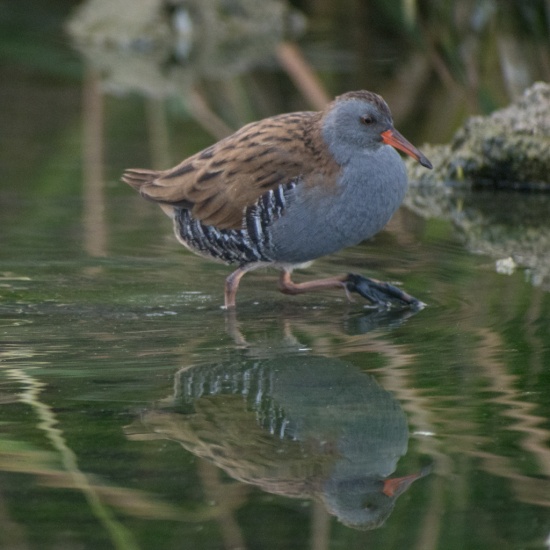
Fernando Alonso
Treated water has favoured extensive reedbeds and its typical birdfauna at Navaseca
Overview
Originally an endorheic laguna associated with the discharge area of the Western Mancha aquifer, the construction in 1998 of the sewage plant of the town of Daimiel brought a significant change to its character. As in other cases in the area, the input of treated sewage has led to a significant functional change, with a part of the wetland it becoming permanent, more eutrophic and with the development of a fringe of Phragmites reeds, while the other only floods after sustained rains.
Nowadays is one of the hotspots for birders in Central Spain. In fact, most of the emblematic species of the neighbouring and best known Tablas de Daimiel National Park are probably easier to observe at Laguna de Navaseca, which is itself within the National Park protection boundary.
Birds
Notable Species
The most notable species are White-headed Duck, Black-necked Grebe, Red-crested Pochard, Greater Flamingo and Western Swamphen, all of them with good numbers and easy to observe. Scarcer, but also with fair chances of observation are Ferruginous Duck and Squacco Heron.
Good numbers of Gadwall, Mallard, Common Teal, Northern Shoveler, Common Pochard and Eurasian Coot and, to a lesser extent Greylag Goose (which has started to breed there) are present all year through. Little Grebe is another abundant species.
The reedbeds hold among other warblers Savi's Warbler and Cetti's Warbler. Penduline Tit and Reed Bunting are also present, as does Bluethroat during winter. Spanish Sparrow roosts in the reeds.
Although not particularly good for waders, some species can be seen on passage including Pied Avocet, Black-winged Stilt, Ruff, Black-tailed Godwit, Dunlin, Common Redshank and Little Ringed Plover among others.
Raptors include a number of Marsh Harrier. Summer visitors frequently seen include Montagu's Harrier, Black Kite and Booted Eagle
Check-list
Greylag Goose, Common Shelduck, Gadwall, Mallard, Northern Shoveler, Common Teal, Northern Pintail, Garganey, Red-crested Pochard, Common Pochard, Ferruginous Duck, White-headed Duck, Red-legged Partridge, Common Quail, Little Grebe, Great Crested Grebe, Black-necked Grebe, Greater Flamingo, White Stork, Great Cormorant, Little Bittern, Western Cattle Egret, Little Egret, Great White Egret, Purple Heron, Squacco Heron, Grey Heron, Black-crowned Night Heron, Glossy Ibis, Eurasian Spoonbill, Booted Eagle, Spanish Imperial Eagle, European Honey Buzzard, Western Marsh Harrier, Montagu's Harrier, Goshawk, Common Buzzard, Red Kite, Black Kite, Osprey, Water Rail, Western Swamphen, Common Moorhen, Eurasian Coot, Common Crane, Stone-curlew, Black-winged Stilt, Pied Avocet, Northern Lapwing, Common Ringed Plover, Little Ringed Plover, Kentish Plover, Black-tailed Godwit, Bar-tailed Godwit, Red Knot, Ruff, Curlew Sandpiper, Temminck's Stint, Sanderling, Dunlin, Little Stint, Common Snipe, Common Sandpiper, Green Sandpiper, Common Greenshank, Spotted Redshank, Wood Sandpiper, Common Redshank, Collared Pratincole, Black-headed Gull, Mediterranean Gull, Lesser Black-backed Gull, Yellow-legged Gull, Little Tern, Gull-billed Tern, Whiskered Tern, Black Tern, Pin-tailed Sandgrouse, European Turtle Dove, Eurasian Collared Dove, Common Wood Pigeon, Rock Pigeon, Great Spotted Cuckoo, Common Cuckoo, Little Owl, Common Swift, Pallid Swift, Eurasian Hoopoe, Common Kingfisher, European Bee-eater, European Roller, Eurasian Wryneck, Iberian Green Woodpecker, Great Spotted Woodpecker, Lesser Kestrel, Common Kestrel, Merlin, Woodchat Shrike Iberian Grey Shrike, Golden Oriole, Eurasian Magpie Eurasian Jackdaw Carrion Crow, Bearded Tit, Calandra Lark, Crested Lark, Sky Lark, Barn Swallow, Red-rumped Swallow, House Martin, Sand Martin, Eurasian Crag Martin, Coal Tit, Crested Tit Blue Tit, Great Tit, Penduline Tit, Eurasian Wren, Cetti's Warbler, Willow Warbler, Western Bonelli's Warbler, Common Chiffchaff, Melodious Warbler, Common Reed Warbler, Great Reed Warbler, Sedge Warbler, Savi's Warbler, Zitting Cisticola, Sardinian Warbler, Dartford Warbler, Western Orphean Warbler, Spotted Flycatcher, European Pied Flycatcher, European Robin, Common Nightingale, Bluethroat, Black Redstart, Common Redstart, Whinchat, European Stonechat, Northern Wheatear, Spanish Sparrow, Eurasian Tree Sparrow, House Sparrow, Rock Sparrow, Eurasian Blackbird, Song Thrush, Spotless Starling, Common Starling, Dunnock, White Wagtail, Western Yellow Wagtail, Gray Wagtail, Water Pipit, Meadow Pipit, Tree Pipit, Reed Bunting, Corn Bunting, Common Chaffinch, Brambling, European Greenfinch, European Serin, Common Linnet, European Goldfinch.
Other Wildlife
Both Rabbit and Iberian Hare (Lepus granatensis) are easy to see in the surrounding area.
Site Information
History and Use
Areas of Interest
Close to Daimiel is the renowned Tablas de Daimiel National Park. Also nearby is the 4.000 year old Motilla del Azuer, one of the most representative archaeological sites of the Bronze Age in the area. Here the most ancient water well in the Iberian peninsula has been uncovered. There are guided visits starting from Daimiel Tourist Office.
Access and Facilities
Laguna de Navaseca is close to Daimiel town, close to national road N-420 and highway A-43, about 170 km south of Madrid and 40 km away from Ciudad Real. To reach Navaseca by car follow the N-420 without driving inside the town of Daimiel (follow the signs to Ciudad Real if coming from Madrid), looking for paved track to right (north) a white “E.D.A.R. Daimiel” (39.082706, -3.613276) sign, by a couple of huge white jars and just before kilometre 389. A 2 km drive leaves you at the car park by the laguna.
Since very recently (2015) the construction of a number of hides by the municipality of Daimiel has improved substantially the visit for birdwatchers. There is a perimetral track that can be walked around comfortably in a couple of hours.
If driving from the parking towards the sewage plant keep in mind that trucks going into the facilities that can arrive at any time.
Binoculars can be useful, although a scope is definitely recommended.
The area is becoming more and more popular to locals for jogging and cycling.
It is possible to combine in the same day the visit to Tablas de Daimiel National Park and perhaps Lagunas de Alcázar. It is worth spending a couple of days including other areas at La Mancha wetlands
Daimiel is a mid-size town where accommodation and restaurants are readily available.
Contact Details
Manager's office (at Ciudad Real city) Servicio Provincial de Agricultura, Medio Ambiente y Desarrollo Rural. c/ Alarcos, 21. 13071 Ciudad Real (SPAIN) Phone: +34 926279500
External Links
Content and images originally posted by Fernando Alonso (fdokykcu)






